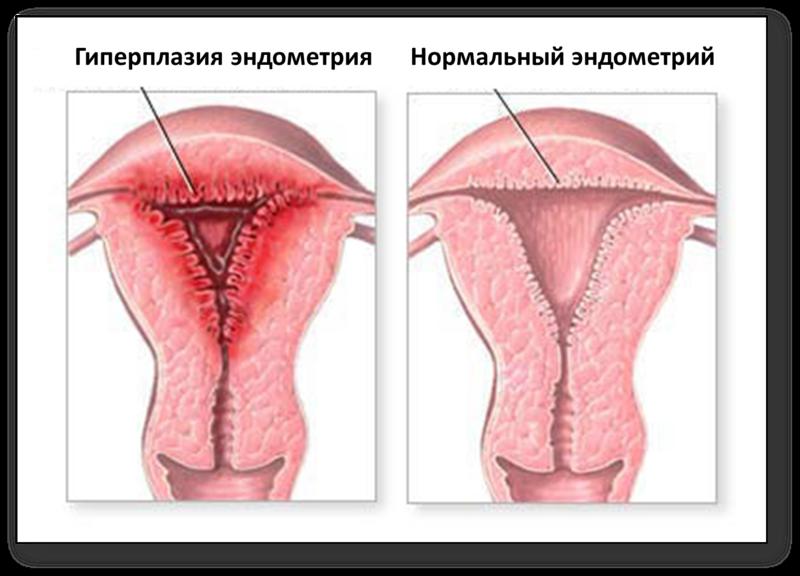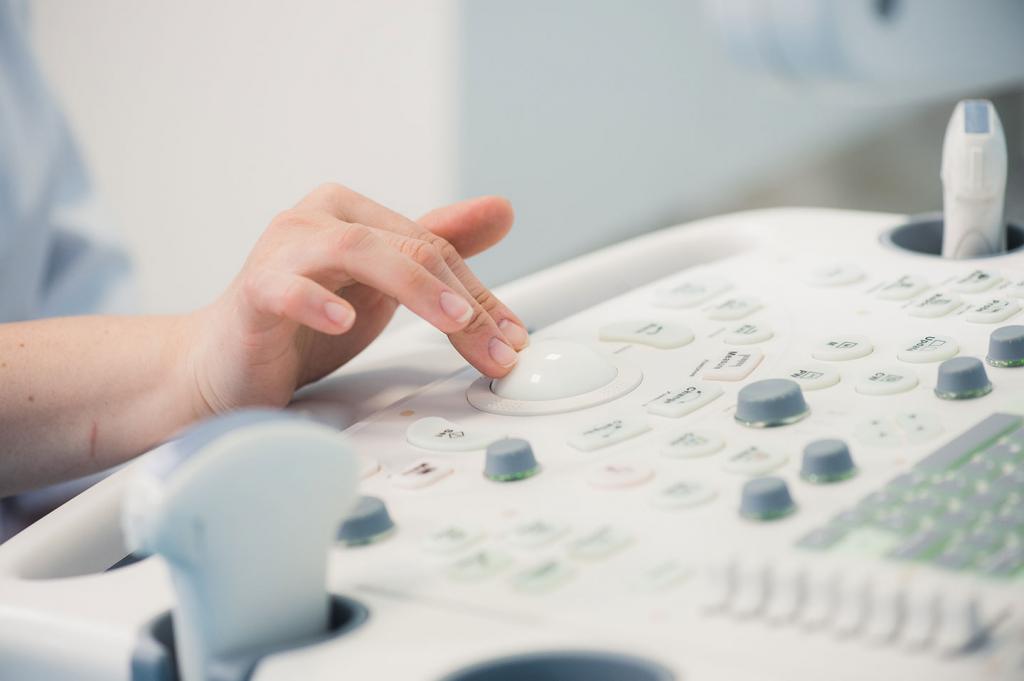Women's health is constantly dependent on hormonal levels. Any of its changes can cause deviations in the body. Some of the most serious hormonal changes occur during a woman’s menopause. For the most part, this concerns changes in the production of estrogen and progesterone. This affects the atrophy of the mucous surfaces of the uterus, which ultimately leads to a complete cessation of menstruation and the extinction of the woman's reproductive function. But in addition to the above, hormonal disruptions can cause the development of pathological processes. For example, there is a norm for the thickness of the endometrium with menopause. Deviation from it may indicate the development of serious diseases. What should be the endometrium with menopause and what are the treatment options for deviations, we will consider in the article.
Endometrial determination

The endometrium is the mucous membrane of the uterine cavity, which plays an important role in the process of bearing the baby and prevents the walls of the organ from sticking together. The endometrium is very susceptible to any changes in the hormonal background, as it contains a large number of receptors, which provide a high sensitivity of the mucosa to hormones. So, in the middle of the menstrual cycle there is an overwhelming number of receptors that respond to estrogen, and in the second half of the cycle to progesterone.
Endometrial growth continues throughout the cycle, preparing for a possible conception and implantation of the embryo. By the end of the cycle, its thickness may exceed the original 10 times. If pregnancy has not occurred, the uterus rejects the functional layer of the mucosa, which is manifested by the onset of menstruation.
The norm of the uterine endometrium with menopause
In women of reproductive age, the thickness of the uterine mucosa is constantly changing under the influence of its cyclical nature. During menopause, the amount of hormones that are produced by the ovaries gradually decreases. In this regard, there is a gradual thinning of the endometrium, it becomes more loose. The final result of these changes should be a fixation of the thickness of the uterine mucosa at a level of 5 mm. If the results of the analyzes revealed an increase in this value, we can talk about the development of the pathological process. In most cases, excess values are found, which is a sign of endometrial hyperplasia. The norm of the thickness of the endometrium with menopause can fluctuate, but not more than 1-2 mm. To confirm the diagnosis, it is necessary to undergo a series of diagnostic measures and, if confirmed, start the necessary treatment. If the results of the examinations indicated an increase in the thickness of the mucosa to 6-7 mm, the patient is put under medical supervision, systematically undergoing an ultrasound procedure. Excessive proliferation of the endometrium can lead to serious consequences.
Types of endometrial hyperplasia
Currently, endometrial hyperplasia during menopause is usually divided into the following types:
- Glandular. At the same time, the connective tissue of the uterus remains unchanged, and it is the glandular cells that grow. It is the most common form of pathology, which, with early detection, is quite successfully treatable. Overgrowing into a malignant nature is rare.
- Cystic With this form of the disease, cysts form, and the epithelial tissue undergoes changes. This form of hyperplasia is dangerous, as it can develop into cancerous formations.
- Cystic glandular. A mixed form of pathology in which overgrown glandular cells form cysts.
- Focal. It occurs quite rarely, but is considered quite dangerous, as it is characterized by the appearance of polyps that are prone to malignancy. Bleeding may be observed. With this form of hyperplasia, strict medical supervision is carried out.
- Atypical. The most dangerous form of the disease. Active reproduction, as well as degeneration of mucosal cells, is observed. The deep layers of the endometrium also undergo changes. This type of pathology requires surgical intervention, since in 60% of cases it ceases to be an oncology. As a rule, with surgical intervention, the uterus is removed.
Causes

The reasons for the increase in the size of the endometrium with menopause are quite extensive. Let's consider them in more detail:
- Hormonal disorders. The most common factor in the development of hyperplasia. Failures in the endocrine system can cause an increase in estrogen levels, which leads to an imbalance.
- Metabolic disorders and obesity. Fat cells are able to synthesize estrogens, exacerbating the imbalance of hormones during menopause.
- Ovarian dysfunction.
- Uterine neoplasms.
- Polycystic
- Diabetes.
- Surgical interventions, including abortion and curettage.
- Genetic predisposition.
- Hypertension.
- Hepatic dysfunction
- Diseases of the kidneys, adrenal glands and pancreas.
- Endocrine diseases.
- Mastopathy
- Autoimmune pathological conditions.
- Smoking and excessive drinking.
- Improper nutrition.
- Long-term use of hormonal drugs or their illiterate purpose.
Symptomatology

As a rule, deviations from the norm of the uterine endometrium with menopause do not have symptoms specific to this pathology. With a more serious proliferation, bleeding may appear, which is often confused with menstrual bleeding, which can still occur during the initial stage of menopause. In most cases, heavy, painful bleeding is observed, but spotting may also bother. Sometimes they appear white or gray.
Reduced performance, headaches and general weakness may also be disturbing.
Diagnostics

Identifying deviations of values from the norm of the endometrium with menopause is not difficult. First of all, if any symptoms appear, you should contact a gynecologist who will conduct an examination and prescribe diagnostic measures, as a result of which effective therapy will be prescribed. To make the most accurate diagnosis, a comprehensive diagnosis is performed, which includes a number of laboratory and instrumental examinations. Let's consider them in more detail.
- The main diagnostic measure is ultrasound, which is carried out intravaginally.
- If the results of ultrasound indicate an increase in the endometrium to 8-9 mm, in most cases a diagnostic curettage of the functional layer of the uterus is carried out, which is carried out under general anesthesia. Next, the cleaned material is sent for histological examination in order to detect atypical cells.
- A biopsy that allows you to determine not only deviations from the norm of the thickness of the endometrium with menopause, but also the presence of pathological processes in it and malignant cells.
- Sometimes an examination using radioactive phosphorus is required. This substance has the ability to accumulate in pathologically altered cells, so that with the help of a specific sensor, it is possible to detect foci of cell growth.
Laboratory methods
Laboratory diagnostic methods include:
- General analysis of urine and blood.
- Taking smears.
- Blood test for hormones.
Treatment

Currently, there are several ways to treat endometrium with menopause in case of its growth, the main of which are conservative and surgical.
Conservative treatment involves primarily the use of hormonal drugs, since any gynecological disorders during menopause are caused by hormonal disruptions.
With an increased size of the endometrium with menopause, the following drugs are prescribed:
- Dufaston.
- Danazol
- Gestrinon.
- "Goserelin" and others.
Hormonal treatment with these drugs has practically no side effects. They also normalize the condition of the mucous cells and prevent their degeneration into a malignant form. Reception of this category of medications should be carried out from 3 months to a year under the supervision of a doctor.
During hormone therapy, drugs are prescribed in parallel that have a protective and regenerative effect on the liver. These include Essential Forte. Blood thinning medications — Hepatrombin and others — may also be recommended.
It happens that the doctor makes a decision on the appointment of gonadotropin-releasing hormone agonists , a side effect of which is an increase in menopausal symptoms.
Surgical treatment

The operational method of treating endometrial hyperplasia is used quite often. Surgical intervention is used in cases of recurrence of the disease, with a polypoid form of pathology and in cases where there is a suspicion of degeneration of mucosal cells into malignant formations.
The operation can be carried out in several ways, from which we will describe below.
- Scraping. This procedure can be used as a diagnostic measure to detect atypical mucosal cells. The operation allows you to slow down the development of the pathological process and stop bleeding.
- Laser moxibustion. A very effective method of treatment, which causes minimal damage to the female body. This method is used to remove individual foci of hyperplasia.
- Cryodestruction. It is used for focal hyperplasia. Cauterization is carried out by exposure to the pathological focus of low temperatures.
- Hysterectomy This term means complete removal of the uterus. It is used in the most extreme case when atypical hyperplasia develops, in which the likelihood of developing oncology is high.
ethnoscience

Sometimes, with a deviation of the endometrial norm values with menopause, the use of traditional medicine is used as an auxiliary therapy. Such treatment helps to normalize the hormonal background and reduces the risk of inflammatory processes. It is important to remember that before taking medicinal herbs, you must consult your doctor.
The most popular recipes for the growth of the endometrium are:
- Linseed oil.
- Pine uterus.
- The infusion is celandine.
- The roots of burdock.
- Nettle tincture.
- Cuff infusion.
- Infusion of plantain leaves.
- Beetroot and carrot juices.
An important point in the treatment of hyperplasia is a diet, in which it is necessary to minimize the use of fatty, flour, sweet, smoked foods. You need to eat more cereals, nuts, fruits and vegetables, as well as foods rich in vitamin C.
Conclusion
Climax is a very difficult period for a woman, both psychologically and emotionally. There is a global hormonal restructuring, during which pathological conditions can develop. Therefore, it is extremely important not to neglect the scheduled visits to the doctor. If abnormalities of the endometrium are detected with menopause, it is necessary to pass the necessary tests and begin treatment. With timely initiation of therapy, the probability of a successful outcome is quite high.